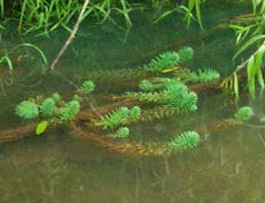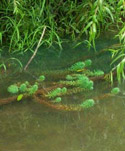Parrotfeather
Myriophyllum aquaticum • Class B |
||
| Family Name: | Haloragaceae family (HAL-uh-ruh-gay-see-ee) | |
| Common: | Watermilfoil family | |
| Genus: |
Myriophyllum (my-ree-oh-FIL-um) Meaning: Numberless leaves |
|
| Species: |
aquaticum (a-KWA-ti-kum) Meaning: Lives in water |
|
| Description: |
Parrotfeather gets its name from its feather-like-leaves which are arranged around the stem in whorls of four to six. Its leaves are both submersed and emergent. The submersed leaves are easily mistaken for Eurasian watermilfoil, a close relative. The darker green submersed leaves have 20 to 30 divisions per leaf. The feathery emergent foliage is longer and has only 6 to 18 divisions per leaf; these are bright green and can grow up to a foot above the water surface and look almost like small fir trees. Parrotfeather flowers are small, white and inconspicuous. |
| Why Is it a Noxious Weed? |
Parrotfeather forms dense mats that shade out other native aquatic plants and alter aquatic ecosystems. These infestations inhibit water flow and cause flooding and drainage problems in shallow rivers and streams.
|
| Where Does it Grow? |
Parrotfeather is found in freshwater ponds, lakes, streams, canals, and appears to be adapted to high nutrient environments. It tends to colonize slowly moving, or still water rather than in areas with higher flow rates. Because the emergent stems have access to atmospheric carbon dioxide, parrotfeather is probably the most productive milfoil species. |
| Facts: |
Infestations can alter aquatic ecosystems by shading out the algae in the water that serves as the basis of the aquatic food system. This plant also serves as choice mosquito larvae habitat. |
| Control Options: |
|
| More Information: |
Download our Flyer or visit Washington State Noxious Weed Control Board Here. Photo by Leo Michels
|
| More Pictures: |




